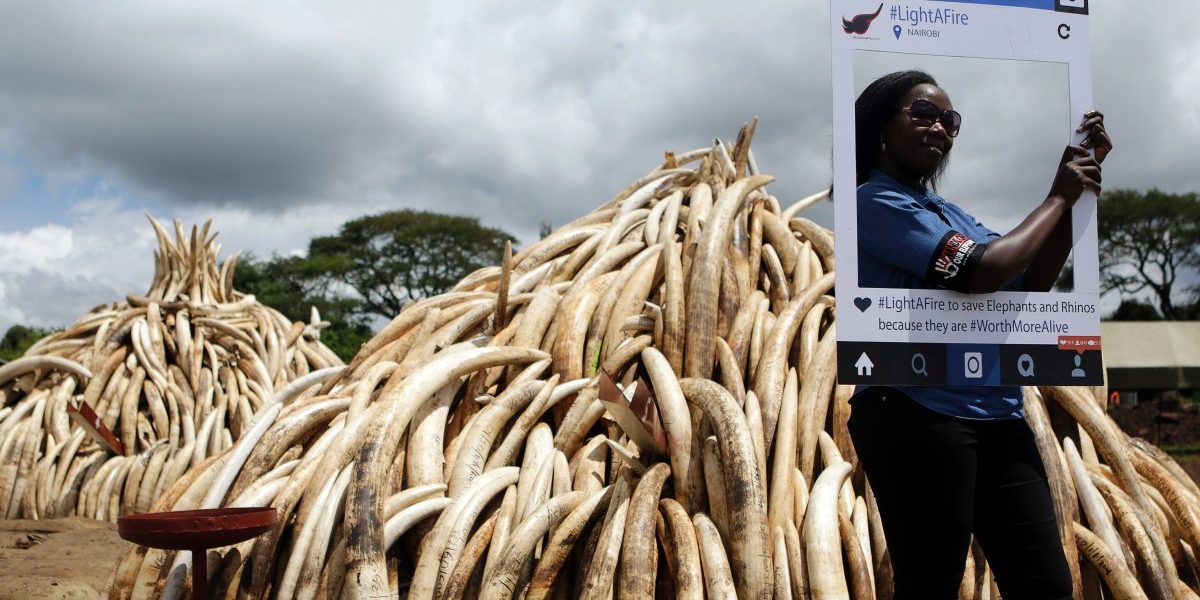Recommendations
- Adopt a ‘One Health’ approach at the regional, national and local level to optimise synergies and improve integration across the related sectors of human health, biodiversity conservation and climate change.
- Initiate and scale nature-positive investments to enhance social well-being, including those that minimise exposure to zoonotic transmissions.
- Support landscape restoration and food security by combatting illegal wildlife trade (IWT) and preventing unregulated land-use change.
- Design COVID-19 pandemic-response green stimulus packages to incorporate the One Health approach and link this to existing global funding sources.
- Prioritise working with and building capacity in local and rural communities most affected by economic decline, and those who live closest to the human–livestock–wildlife interface and areas of origin of IWT.
Executive summary
The COVID-19 pandemic has had a disastrous impact on the global economic and social fabric. Zoonotic disease spill-over from other species has become a familiar phenomenon, and the need for a more proactive approach to minimise exposure to and opportunities for spill-over is widely recognised. In particular, it is crucial to incorporate measures to combat illegal wildlife trade (IWT) in cross-sectoral policies addressing the triple challenges of human health, biodiversity loss and the climate crisis. Implementing an integrated One Health approach is estimated to cost one-hundredth of the economic damage that pandemics produce. This policy brief recommends incorporating the combatting of IWT into a much wider-ranging, multi-sectoral One Health approach for Africa.
Introduction
The devastating global to local economic and social impacts of the ongoing COVID-19 pandemic are now well known. Some three-quarters of emerging diseases, including almost all pandemics (eg, HIV/Aids, COVID-19), are caused by pathogens of animal origin, ie zoonoses. These spill over owing to contact among and between wildlife, livestock and people. Given this long history of zoonotic spill-over from other species, the current scientific opinion is that the most likely source of COVID-19 is zoonotic transmission from an as-yet unverified host animal species in a wildlife ‘wet market’ in Wuhan, China. Consequently, there has been speculation and recommendations as to how to prevent future transmissions of novel zoonotic diseases through wet markets. These include banning them completely and banning all trade in wildlife, whether for consumptive or non-consumptive use, especially the illegal and thus unregulated trade. However, since millions of people worldwide depend on wet markets for both food and work, and on wildlife meat (as well as domestic livestock and seafood products, also sold at wet markets) as a primary source of protein, such blanket bans are unworkable. Of more concern is that they would likely push the wildlife trade underground, exacerbating the already worrying global illegal wildlife trade (IWT). Inadvertently driving the expansion of IWT, by definition unregulated, would not only increase the risk of further zoonotic spill-over but also undermine biodiversity conservation efforts. A radically different policy approach is needed to avoid such maladaptations. This policy brief, while dealing specifically with the role of IWT, recognises it is just one piece of the puzzle and recommends incorporating the combatting of IWT into a much wider-ranging ‘One Health’ approach for Africa.1For a detailed explanation of the complexities of the One Health approach, see Chet Trivedy, “Solving the One Health Puzzle”, Biodiversity 21, no. 1 (2020): 1–8.
The illegal wildlife trade in context
The world is in the midst of a well-documented biodiversity crisis, with wildlife populations plummeting and species extinctions occurring at unprecedented rates. These trends are driven by habitat destruction, over-use, climate change and the illegal harvesting of and trade in wildlife.2Intergovernmental Science-Policy Platform on Biodiversity and Ecosystem Services, The Global Assessment Report on Biodiversity and Ecosystem Services (Bonn: IPBES, 2019).In Africa, as elsewhere, devastating declines in biodiversity are on the rise, despite the fact that the natural resource base is still relatively intact. For example, the African forest elephant experienced a population crash of approximately 62% and a 30% reduction in its geographical range in just one decade between 2002 and 2011.3Fiona Maisels et al., “Devastating Decline of Forest Elephants in Central Africa”, PLoS ONE 8, no. 3 (2013): e59469.Rapid human population growth driving encroachment, illegal hunting, poor law enforcement, and expanding infrastructure such as roads and mines were found to be the main drivers of this decline – threats that are becoming increasingly pervasive across the continent.4IPBES, The Regional Assessment Report on Biodiversity and Ecosystem Services for Africa (Bonn: IPBES, 2018).
A recent analysis of the wildlife trade database held by the Convention on International Trade in Endangered Species of Wild Fauna and Flora (CITES), the international treaty mandated to regulate such trade and ensure sustainable use, found that in just two decades (from 1998 to 2018) over 421 million individual threatened wild animals were traded across borders.5Jia Huan Liew et al., “International Socioeconomic Inequality Drives Trade Patterns in the Global Wildlife Market”, Science Advances 7, no. 5 (2021).The bulk of the trade was from lower-income countries to richer ones, suggesting that higher prices are obtained outside countries of origin, increasing the potential for zoonotic disease transmission. The analysis raised concerns regarding the incompleteness of the data, the unsustainable harvesting of certain species and the impact on biodiversity conservation in general, and the potential for the regulated wildlife trade to enable laundering of IWT.
According to the latest UN Environment Programme (UNEP)–Interpol evidence, globally IWT is estimated to be worth up to $20 billion per year and rising. IWT comprises both illegal hunting and poaching for local consumption (‘bushmeat’) and transboundary trade through organised crime syndicates. The latter links IWT to other organised crime activities such as the illegal arms and drugs trade, as well as funding of militias in countries of origin. In addition to human health risks, IWT is thus also a serious contributor to social conflict and economic loss in source countries in particular.
However, it is important to note that concerns are also being raised regarding the risks from the legal wildlife trade in enabling disease spill-overs. The threat posed by the legal wildlife trade should be at least of equal concern as IWT, and the two addressed simultaneously:6Vincent Nijman, “Illegal and Legal Wildlife Trade Spreads Zoonotic Diseases”, Trends in Parasitology 37, no. 5 (2021).
Given that in many instances the legal wildlife trade is several orders of magnitude larger than the illegal trade, incredibly serious risks are associated with the trade in wildlife, regardless of whether the species involved are traded legally or illegally. It is ineffective and possibly dangerous to focus on the illegal wildlife trade only.
Fortunately, this recognition is now permeating the policy arena, with the most recent CITES Standing Committee meeting in May 2021 noting that it is essential to address the zoonotic risks and vulnerabilities inherent in the legal wildlife trade.7“Summary of the 73rd Meeting of the CITES Standing Committee: 5-7 May 2021”, Earth Negotiations Bulletin 21, no. 102 (May 10, 2021).Member countries, especially countries of wildlife trade origin (which includes many African countries), should urgently look at improving the role of the convention in preventative oversight of IWT together with reducing the threat of zoonotic transmissions.
Responses to the COVID-19 pandemic and its impact on IWT
The COVID-19 pandemic has undoubtedly impacted biodiversity conservation and IWT in several ways. The impact on IWT is an emerging field, and difficult to measure given the illegal nature of IWT activities and their long, cryptic and convoluted supply chains. However, certain key elements have emerged, most especially the impact of lockdowns in increasing poverty and driving IWT.
The introduction of travel restrictions has reduced business travel and tourism overall, but most specifically ecotourism, and the associated income in biodiverse-rich countries has all but disappeared. This has collapsed most local employment options and associated income streams for rural communities in and near protected areas harbouring the charismatic wildlife and scenic landscapes ecotourists travel to see and experience.
Interviews with convicted wildlife offenders held in South African jails found that all offenders cited multiple socio-economic factors influencing or rationalising their decision to engage in IWT. Broadly, these included income generation, livelihood opportunity, normalisation (contested illegality), the lack of state legitimacy and a limited perception of the risks or consequences of participating in IWT. Over two-thirds claimed to have been forced into crime to survive.8Sade Moneron, Adam Armstrong and David Newton, The People Beyond the Poaching, Report (Cambridge: TRAFFIC, 2020).
Given the influence of socio-economic factors on motivating participation in IWT in countries of origin, the impact of the pandemic on unemployment and poverty is profound. According to the Global Report on Food Crises 2021, the COVID-19 pandemic has dramatically exacerbated the impacts of other drivers of food insecurity (such as ongoing conflict and climate change), raising figures globally to a five-year high by some 20%. Six of the top 10 countries affected are in Africa. The report forecasts that, while conflict will remain the main driver in 2021, the economic fallout of COVID-19 will exacerbate food insecurity in fragile economies.9Food Security Information Network and Global Network Against Food Crises, Global Report on Food Crises 2021 (Rome: World Food Programme, 2021).Without urgent and targeted interventions, rural populations in particular will be forced to turn increasingly to natural resources to sustain themselves.
On a more positive side, the lockdowns, even where poorly policed, are understood to have curtailed much illegal wildlife poaching for trade, and disrupted global trade links. For example, South African National Parks has reported that local rhino poaching declined by 33% during 2020, with much of this ascribed to the global lockdowns.10Chris Gilili, “‘Extreme’ Tactics and Lockdown Buy Rhino More Time”, Mail & Guardian, March 5, 2021.However, such lockdown-induced reductions are regarded as temporary unless other measures are put in place.11Liew et al., “International Socioeconomic Inequality”.
Further, it appears that the online commercial IWT has not diminished despite the widely publicised threat of disease transmission. Rather, lockdowns have been used as encouragement to purchase ‘exotic pet lockdown companions’.12Thais Morcatty et al., “Online Trade in Wildlife and the Lack of Response to COVID-19”, Environmental Research 193 (2021).The study concludes that campaigns to ban wildlife markets as potential spill-over hotbeds have not discouraged online wildlife trade per se, but only changed the nature of it.
While some parties have advocated a complete ban on wildlife trade to prevent outbreaks and protect biodiversity, a comprehensive new study of food systems across 83 countries suggests that, far from solving the problem, a sudden blanket ban may actually exacerbate it.13Holly Booth et al., “Investigating the Risks of Removing Wild Meat from Global Food Systems”, Current Biology 31, no. 8 (2021): 1788–1797.The analysis compared the volume of livestock protein required to replace the wildlife protein lost through a ban, concluding this would have a huge negative impact on biodiversity with over 120 000km² of new agricultural land needed for replacement livestock farming. Given that the vast majority of zoonotic spill-overs have originated where agriculture is pushing further into intact biodiversity habitats, the study suggests such a ban would not just further threaten numerous species through habitat loss but also increase the risk of future pandemics through increased exposure.
An integrated response to IWT, zoonotics and global challenges
Among the key policy recommendations to prevent future pandemics that arose from UNEP’s Fifth Science-Policy Forum for Biodiversity held virtually in April 2021 in the lead-up to the Fifth UN Environment Assembly (UNEA5) was the need for greater nature-positive investments. These include halting unregulated land-use change, supporting ecosystem restoration and making food systems nature-positive. Further, the Leadership Dialogue at UNEA5 explicitly recognised that ‘[t]he health of nature and human health are inextricably linked’.14UN Environment Programme, “Summary of Key Messages from the Leadership Dialogue: Contribution of the Environmental Dimension of Sustainable Development to Building a Resilient and Inclusive Post-Pandemic World”, February 22–23, 2021.
In attempts to prevent future zoonotic pandemics, blaming wildlife for the spill-over of zoonoses is misplaced and distracting. Emergence is caused by human activities, most notably habitat destruction in the form of deforestation and proximity to, interaction between and with, and consumption of livestock and wildlife.15P Daszak et al., IPBES Workshop Report on Biodiversity and Pandemics (Bonn: Intergovernmental Science-Policy Platform on Biodiversity and Ecosystem Services Secretariat, 2020).This tendency has determined that our general approach to pandemics to date has been post facto, based on emergency containment and control after an outbreak has occurred. The more strategic approach would seek to reduce the drivers of pathogen emergence. Identifying potential geographic sites of pathogen reservoirs, as well as how environmental and socioeconomic changes correlate with disease emergence, could predict causal changes with human health impacts. This outlines the so-called ‘One Health’ approach widely promoted by the World Health Organization, among other key players.16“Strengthen ‘One Health Approach’ to Prevent Future Pandemics – WHO Chief”, UN News, February 17, 2021; UNEP, Making Peace with Nature: A Scientific Blueprint to Tackle the Climate, Biodiversity and Pollution Emergencies, Global Synthesis Report
Bringing human and environmental health concerns together in an integrated response enables governments to develop a multi-sectoral policy and practice strategy. Possibly the most compelling argument for such an integrated One Health approach is that it is estimated to cost just one-hundredth of the damages pandemics produce.17Daszak et al., IPBES Workshop Report.Currently, disease surveillance regulations across the spectrum of global wildlife trade are too limited in scope, too dispersed among various agencies, inconsistently applied, and open to evasion through bribery, corruption and other criminal activities. It is critical to embed a One Health approach across national governments, and across national boundaries, to build cross-sectoral and transboundary emergence awareness, and detection and transmission prevention programmes. The capacity to investigate, track and source outbreaks is also key to halting future pandemics.18Trivedy, “Solving the One Health”.
Building the One Health approach into green economic recovery from COVID-19
The analysis of the CITES trade database revealed that ‘international socioeconomic inequality drives trade patterns in the global wildlife market’ and that current efforts to slow the global wildlife trade are insufficient.19Liew et al., “International Socioeconomic Inequality”.The COVID-19 pandemic has given impetus to improve rapidly the global governance of wildlife trade, given concerns over unsustainable use, IWT and transmission pathways for zoonotics. As a result, the study recommends that the most socially equitable approach would be to offer source countries financial incentives in return for commitments to reduce wildlife trade and enhance governance. This will help to address all three major concerns: ‘While imperfect, we believe that incentive-driven policies are an upgrade on existing international agreements on wildlife trade as they may provide source nations with adequate resources for navigating the cultural complexities underlying wildlife harvesting.’ 20Liew et al., “International Socioeconomic Inequality”.
This suggestion is timely, as countries are developing pandemic stimulus packages. In particular, the mantra of ‘green stimulus packages’ is at the forefront of such policies, with the intention to inject funding into addressing the triple challenges of climate change, biodiversity loss and human health together. Poorer countries can take advantage of this by committing to outcomes already agreed to under the UN Sustainable Development Goals, UN Convention on Biological Diversity (CBD) and UN Convention for Combatting Climate Change, and insisting that funding promises made under these conventions by developed countries are met.
The CITES analysis revealed that a large percentage of wildlife trade occurs bilaterally between specific pairs of countries. Opportunities thus exist for directing debt-for-nature swaps and the growing arena of biocredits, including payment for ecosystem services and other green financial instruments where bilaterally relevant.21Nicholas King, “Conservation Finance Options to Support African Post-2020 Biodiversity Priorities” (Occasional Paper 325, SAIIA, Johannesburg, 2021).Broadly speaking, poorer countries still harbour most of the world’s biodiversity. As a result, not only will directing green funding towards an integrated One Health approach help prevent further zoonotic spill-over, it will also greatly assist in helping poorer nations meet the objectives of the CBD, including clamping down on IWT and improving biodiversity conservation in general. Such directed funding and commitments align with numerous global to national policy agreements. For example, the CBD’s Aichi Target 20 explicitly recognised that additional funding was needed for countries that are biodiversity richer yet economically poorer.
It is critical to ensure that relevant proportions of such economic stimuli are directed to those communities hardest hit by pandemic livelihood disruptions and food insecurity wrought by the challenges of climate change and biodiversity loss. This will enable improvements in their health and wellbeing, as well as their involvement in and commitment to the One Health approach. Paying people to protect and benefit from their local wildlife, including through investments in alternative livelihoods (most especially where these livelihoods are linked to wildlife, eg, ecotourism), is the most effective means of reducing both IWT and local consumption and thus reducing pathogen spill-over risk. Fortunately, integrated solutions increasingly recognise the need for improved engagement with rural and indigenous communities to ensure that efforts to protect habitats and end illegal wildlife activities do not penalise them.22Global Environment Facility, “Congressional Briefing: The GEF and the COVID-19 Pandemic”, August 5, 2020.
Conclusion
Addressing the combined environmental challenges of the early 21st century – human health, biodiversity loss and climate change – calls for a more integrated, strategic policy framework than has been achieved to date through various thematic treaties running in parallel. One such framework gaining considerable traction is the One Health approach. This is designed to integrate environmental and human health interventions into a single coherent strategy, whereby the links between environmental destruction, biodiversity loss and human health are identified, recognised and addressed as one. For Africa, the One Health approach provides a consistent, comprehensive and cost-effective platform for taking on these challenges that should be adopted and promoted at national and regional (AU) levels.
Acknowledgement
SAIIA gratefully acknowledges the support of the Swedish International Development Cooperation Agency (SIDA) for this publication.







